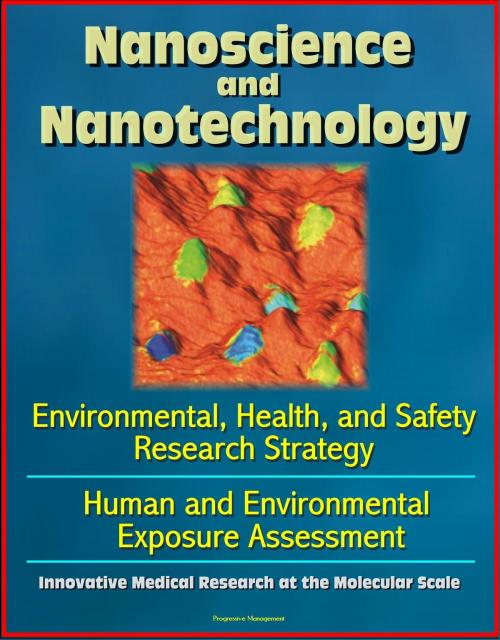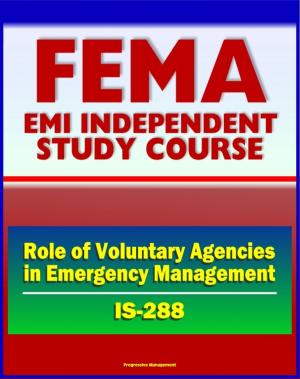Nanoscience and Nanotechnology: Environmental, Health, and Safety Research Strategy, Human and Environmental Exposure Assessment, Innovative Medical Research at the Molecular Scale
Nonfiction, Science & Nature, Technology, Nanotechnology| Author: | Progressive Management | ISBN: | 9781301809813 |
| Publisher: | Progressive Management | Publication: | May 26, 2013 |
| Imprint: | Smashwords Edition | Language: | English |
| Author: | Progressive Management |
| ISBN: | 9781301809813 |
| Publisher: | Progressive Management |
| Publication: | May 26, 2013 |
| Imprint: | Smashwords Edition |
| Language: | English |
This compendium of official government documents provides a thorough overview of the environmental, health, and safety aspects of nanotechnology. The same unique properties that characterize nanomaterials enabling new applications also carry potential risks to human health and the environment. To maximize benefits and minimize potential risks from nanotechnology, the National Nanotechnology Initiative (NNI) agencies have developed a research strategy specifically focused on environmental, health, and safety (EHS) aspects of the field. This strategy will guide Federal agencies as they establish their own nanotechnology research programs.
Integration of risk assessment with the study of life stages of nanotechnology-enabled products (NEPs) permits identification of critical risk assessment data needs. These data needs have been translated into nanoEHS research needs and organized into core nanoEHS research categories: (1) Nanomaterial Measurement Infrastructure, (2) Human Exposure Assessment, (3) Human Health, (4) Environment, and (5) Risk Assessment and Risk Management Methods. The adaptive management process also identified (6) Informatics and Modeling and ethical, legal, and societal implications of nanotechnology as important additions to the strategy.
Since its inception, the National Nanotechnology Initiative (NNI) has funded research on potential environmental, health, and safety (EHS) effects of nanoscale science, engineering, and technology to support the responsible development of novel nanoscale materials and product functionalities. One of the reports in this collection summarizes discussions that took place during the NNI Workshop on Human and Environmental Exposure Assessment held February 24-25, 2009, in Bethesda, MD, a topical workshop convened to determine the state of the science in exposure assessment as it relates to nanotechnology. This workshop led off a series of four nanotechnology-related EHS workshops organized by the Nanotechnology Environmental and Health Implications (NEHI) Working Group of the National Science and Technology Council's Nanoscale Science, Engineering, and Technology (NSET) Subcommittee. The purpose of the EHS workshop series was to assess ongoing progress and to identify gaps and barriers with respect to the research needs and goals identified in the NNI's 2008 Strategy for Nanotechnology-Related Environmental, Health, and Safety Research. The proceedings from this series of workshops will be used to help inform the NNI as it adaptively manages its EHS research strategy.
The ultimate goal is the safe, responsible, and sustainable development of engineered nanomaterials. The emerging area of nanotechnology provides new opportunities for scientists from a variety of disciplines, including exposure science, to advance the science of assessing the behaviors of these novel materials in multiple environments. It is important for funding agencies and manufacturers of nanomaterials to specifically allocate resources for this endeavor and to encourage hazard assessments to be conducted in tandem with exposure assessments, so that they can result in meaningful information to manage any possible health risks of nanomaterials. The long-term viability of nanomaterials and public acceptance of nanotechnology will depend on ability to adequately assess the potential health risks due to exposures from nanomaterials throughout their life cycles.
Contents: Environmental, Health, and Safety Research Strategy; Leading to a Revolution in Technology and Industry that Benefits Society; Human and Environmental Exposure Assessment; National Nanotechnology Initiative Environmental, Health, and Safety Research Strategy 2011; Environmental, Health, and Safety Research Needs for Engineered Nanoscale Materials - The National Nanotechnology Initiative; Innovative Medical Research at the Molecular Scale
This compendium of official government documents provides a thorough overview of the environmental, health, and safety aspects of nanotechnology. The same unique properties that characterize nanomaterials enabling new applications also carry potential risks to human health and the environment. To maximize benefits and minimize potential risks from nanotechnology, the National Nanotechnology Initiative (NNI) agencies have developed a research strategy specifically focused on environmental, health, and safety (EHS) aspects of the field. This strategy will guide Federal agencies as they establish their own nanotechnology research programs.
Integration of risk assessment with the study of life stages of nanotechnology-enabled products (NEPs) permits identification of critical risk assessment data needs. These data needs have been translated into nanoEHS research needs and organized into core nanoEHS research categories: (1) Nanomaterial Measurement Infrastructure, (2) Human Exposure Assessment, (3) Human Health, (4) Environment, and (5) Risk Assessment and Risk Management Methods. The adaptive management process also identified (6) Informatics and Modeling and ethical, legal, and societal implications of nanotechnology as important additions to the strategy.
Since its inception, the National Nanotechnology Initiative (NNI) has funded research on potential environmental, health, and safety (EHS) effects of nanoscale science, engineering, and technology to support the responsible development of novel nanoscale materials and product functionalities. One of the reports in this collection summarizes discussions that took place during the NNI Workshop on Human and Environmental Exposure Assessment held February 24-25, 2009, in Bethesda, MD, a topical workshop convened to determine the state of the science in exposure assessment as it relates to nanotechnology. This workshop led off a series of four nanotechnology-related EHS workshops organized by the Nanotechnology Environmental and Health Implications (NEHI) Working Group of the National Science and Technology Council's Nanoscale Science, Engineering, and Technology (NSET) Subcommittee. The purpose of the EHS workshop series was to assess ongoing progress and to identify gaps and barriers with respect to the research needs and goals identified in the NNI's 2008 Strategy for Nanotechnology-Related Environmental, Health, and Safety Research. The proceedings from this series of workshops will be used to help inform the NNI as it adaptively manages its EHS research strategy.
The ultimate goal is the safe, responsible, and sustainable development of engineered nanomaterials. The emerging area of nanotechnology provides new opportunities for scientists from a variety of disciplines, including exposure science, to advance the science of assessing the behaviors of these novel materials in multiple environments. It is important for funding agencies and manufacturers of nanomaterials to specifically allocate resources for this endeavor and to encourage hazard assessments to be conducted in tandem with exposure assessments, so that they can result in meaningful information to manage any possible health risks of nanomaterials. The long-term viability of nanomaterials and public acceptance of nanotechnology will depend on ability to adequately assess the potential health risks due to exposures from nanomaterials throughout their life cycles.
Contents: Environmental, Health, and Safety Research Strategy; Leading to a Revolution in Technology and Industry that Benefits Society; Human and Environmental Exposure Assessment; National Nanotechnology Initiative Environmental, Health, and Safety Research Strategy 2011; Environmental, Health, and Safety Research Needs for Engineered Nanoscale Materials - The National Nanotechnology Initiative; Innovative Medical Research at the Molecular Scale















